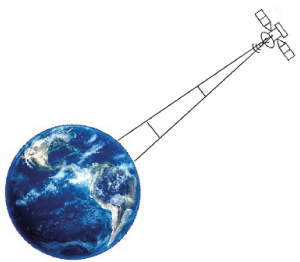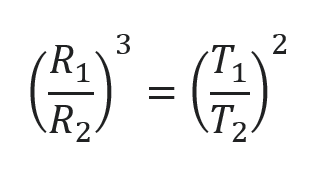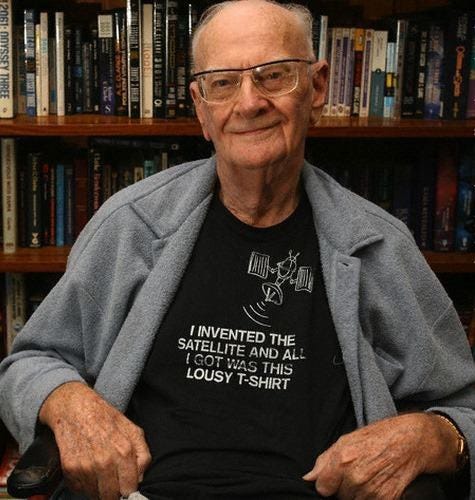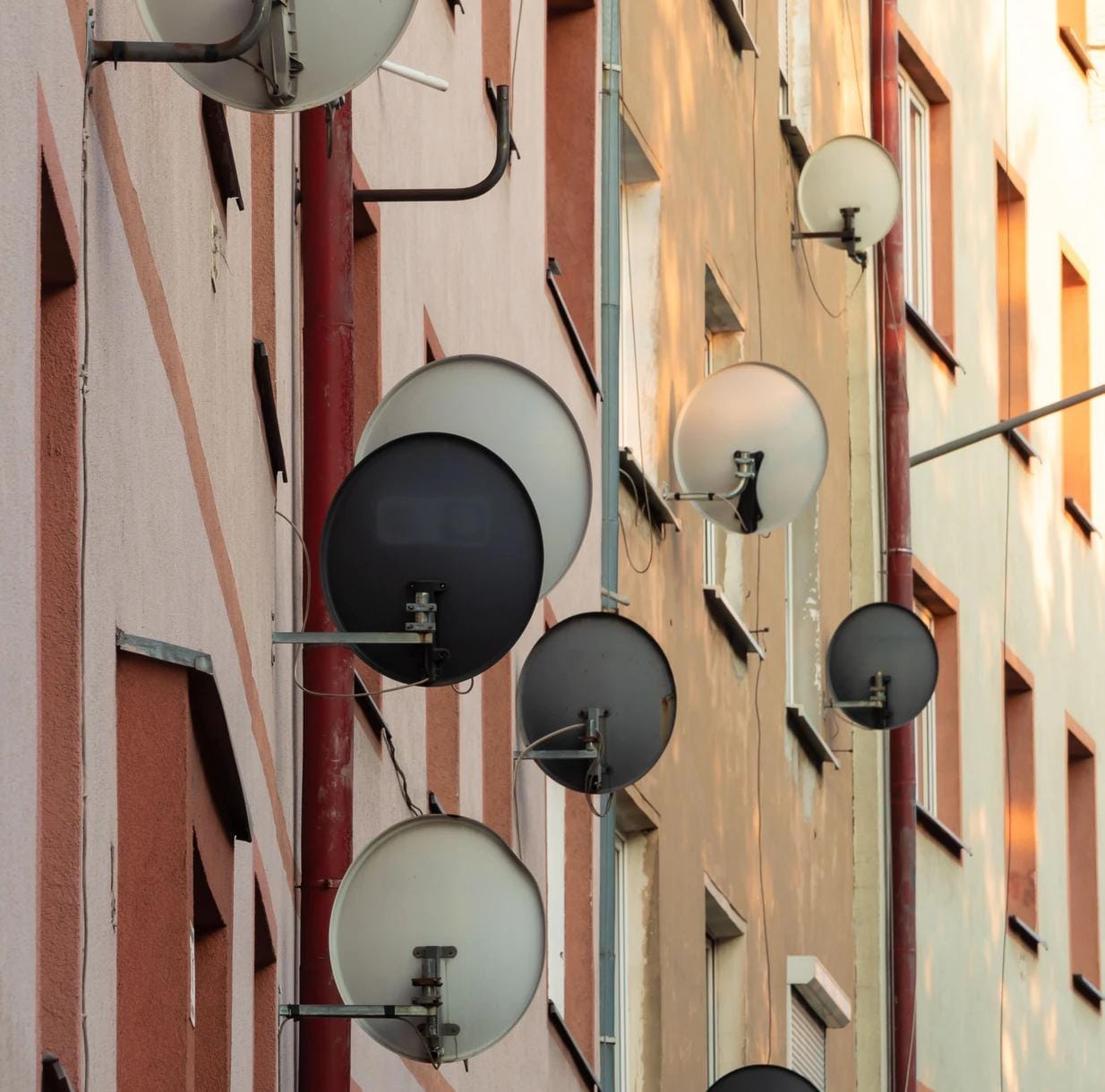Geostationary Satellites
mar 13 2023How to build a 37,500 km tall tower.
By Marcos Chiquetto

Pay TV can reach our home by cable or by an antenna like this one:

When the antenna is installed, the technician must position it so that it captures the signal from the satellite.
Yes, the antenna points to a satellite. But the Earth rotates on its axis and the satellite goes around the Earth! How can a fixed antenna point to a satellite all the time?
The only way this can happen is if the satellite is stationary in relation to the Earth, i.e., it must always be in the same position when seen by us, as if it was fixed on the top of a gigantic tower. The figure below shows this idea.

But a tower that high cannot be built. What one does is put the satellite into a circular orbit* in which the time it takes to go around the Earth once is exactly equal to the time it takes the Earth to complete one rotation (1 day, or 24 hours). Hence, as long as the orbit is above the equator, the satellite will rotate together with the Earth and remain at rest in relation to it.
The period for the circular motion of a satellite around the Earth (the time for it to complete one revolution) depends on the radius of the orbit, i.e., the distance from the satellite to the center of the Earth. The greater the distance, the longer it will take for one revolution. Satellites that are close to the Earth rotate around the planet with very short periods whereas more distant satellites have longer periods.
I will now show a result that can be obtained using classical mechanics (developed by Isaac Newton in the 17th century). Don’t worry if you hate physics and hate math even more. This is the only time I will mention these in the article and you won’t need to go into them in any more detail to understand what comes later.
Consider two satellites above the Earth with circular orbits whose radii are R1 and R2 and periods are T1 and T2:

The relationship between these quantities is:

What will we use this formula for?
Well, there is a satellite that we all know very well: the Moon. This satellite of ours goes around the Earth in 27.3 days** and its orbit has a radius of 384,000 km. We want another satellite whose period of rotation is exactly one day. What should the radius of its orbit be? As the period is shorter than that of the Moon (27.3 times shorter), the satellite will be closer to the Earth.
The following figure shows this situation (so that you have a better idea of the proportions, the sizes of the Earth and the Moon and the distance between them are to scale):

We thus have:
Moon
period: 27.3 days
radius of the orbit: 384,000 km
Desired satellite
period: 1 day
radius of the orbit: r (we want to calculate this)
Putting these numbers in the formula, we get r = 42,000 km.
Therefore, a satellite that rotates around the Earth in an orbit whose radius is 42,000 km has a period of exactly one day.
If, in addition, the orbit of the satellite is in the plane of the Earth’s equator, the satellite will rotate around the Earth just as the Earth rotates on its axis and remain at rest in relation to us. This type of orbit is called a geostationary orbit.
Our planet has a radius of 6,300 km. If we subtract this value from the radius that we have just calculated, we will get the distance from the surface of the Earth to the satellite, i.e., the height of the satellite.
Height of the satellite = 42,000 km — 6,300 km
Height of the satellite = 35,700 km
The figure shows this (the radius of the Earth and the satellite’s orbit are to scale):

35,700 km is approximately six times the Earth’s radius (6,300 km).
With this system, the TV transmitter transmits to the satellite, which then sends the signal back as if the satellite were attached to a gigantic tower:

— But why go to all this trouble? Wouldn’t it be easier to transmit directly from the transmitter to the subscriber’s home? Why does the signal have to travel tens of thousands of kilometers to get to somewhere just down the road?
The problem is that pay TV operates in the microwave frequency band. In this band communication is only possible between two points if there is direct line of sight between them, i.e., if you can see one point from the other (even if this requires a binoculars or telescope). As the Earth is round this only happens over short distances. Because of the curvature of the planet, the other point disappears from your line of sight as it moves farther away. For example, if a transmitting antenna is on a tower 25 m high located in a region where the land is flat, the line of sight will only extend over 20 km. At distances over 20 km the transmission will not be received.
If TV were to be transmitted by microwave using towers, a lot of towers would be needed. Instead, a very powerful transmitter that sends the signal to a geostationary satellite is installed; the signal is then transmitted back by the satellite and can be received by almost half the planet. It is as if the satellite were on a tower 35,700 km high.
— But that way I cannot see how something could be transmitted from New York to Australia, which is on the other side of the planet.
Yes, with only one satellite you cannot go around the word. But with a set of satellites, you can transmit to any point on Earth.

— To do this there must be various satellites orbiting the Earth. Are there a lot?
According to Wikipedia, in August 2020 there were 2,787 artificial satellites orbiting the Earth and these belonged to private companies or state-owned agencies in different countries. Of these satellites, 1,364 were used for communications and hundreds of them were geostationary.
The idea of using a geostationary satellite for communications was proposed by Arthur Clarke, an English physicist who became famous around the world as an author and scriptwriter for the film “2001 — A Space Odyssey”.

The Soviet scientists Mikhail Tikhonravov and Sergey Korolev also proposed the idea of geostationary satellites for communication purposes, at around the same time, but Clarke’s initiative became better known.
Geostationary satellites play an important role in “Independence Day”, an American film released in 1996.

At the beginning of this article we saw that the installation technician must position the antenna so that it can capture the signal from the satellite. The inclination of the antenna in relation to the vertical depends on the latitude of the location. See in the figure what the inclination of the antenna would be for a city on the equator, such as Singapore, Kinshasa or Belém do Pará, and for a city far from the equator, such as New York, London or Paris.

At the equator, the antenna’s axis is almost vertical (not necessarily vertical because the satellite may not be exactly over the location). Far from the equator, the axis is quite inclined. The following photos show this.


Pay TV transmission is unidirectional, from the transmitter station to the subscriber’s home, and can be by cable or geostationary satellite, as has been shown here. However, the internet requires bidirectional communication (the user sends and receives information). Internet traffic can also be transmitted over cable but not by ordinary satellite TV antennae as these can only receive a signal. Small, low-cost antennae like the one in the photo at the beginning of this article cannot transmit a signal to a satellite 37,500 km away. Because of this, cable TV operators offer Internet services but satellite TV operators do not.
Interestingly, the network of microwave towers that was avoided when the decision was made to transmit TV via geostationary satellites ended up being built for cell phones. The landscape today is dotted with microwave towers that provide low-cost bidirectional communications for millions of cell phones. Cell phone operators take advantage of this resource and also offer Internet access based on what is now fourth generation (4G) technology.
Transmitting pictures over the Internet is becoming increasingly popular, with various streaming services now available, and the trend is for this new technology to end up replacing traditional pay TV. Thus, in the near future, geostationary satellites will continue to exist for higher volume communications. Pay TV antennae, however, will probably disappear from homes.
* Satellites generally have elliptical orbits. For a satellite to be geostationary, the orbit must be circular, which is a specific case of an elliptical orbit.
** The period for the Moon to go around the Earth is 27.3 days considered from the perspective of the stars (sidereal period). However, for us on Earth the Moon’s period seems like 29.5 days, which is the duration of the four phases (new, waxing, full and waning). This difference is due to the Earth’s movement around the Sun, which is constantly changing the perspective from which we observe the Moon.

I am an engineer, physics teacher, translator, and writer. I am also director of LatinLanguages, a translation agency that provides multilingual companies and final clients with translation into Portuguese and Spanish. If you work with these languages, we are your best option—delivering world-class service at Brazilian prices.
Marcos Chiquetto




